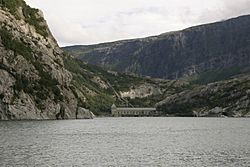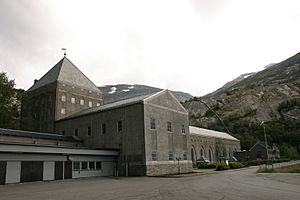Operation Musketoon facts for kids
Quick facts for kids Operation Musketoon |
|||||||
|---|---|---|---|---|---|---|---|
| Part of the Second World War | |||||||
 Glomfjord power plant at the end of Glomfjord |
|||||||
|
|||||||
| Belligerents | |||||||
| Commanders and leaders | |||||||
| Units involved | |||||||
| No. 2 Commando Norwegian Independent Company 1 |
340th Infantry Regiment 233rd Artillery Regiment (from 196th Infantry Division) |
||||||
| Strength | |||||||
| United Kingdom: 10 commandos Norway: 2 commandos |
|||||||
| Casualties and losses | |||||||
| 1 killed 7 captured (later executed) |
2 killed 2 wounded |
||||||
Operation Musketoon was a secret mission during the Second World War. It was a joint British and Norwegian commando raid. The goal was to attack a German-controlled power plant in Glomfjord, Norway. This mission took place from September 11 to 21, 1942.
The team included ten British commandos and two Norwegian soldiers. They traveled across the North Sea by submarine. When they arrived in Norway, they attacked the Glomfjord power plant. They damaged it so badly that it could not be used for the rest of the war.
After the raid, the commandos split into two groups. One group of four men managed to reach Sweden. From there, they returned safely to the United Kingdom. The second group was captured by German forces. One soldier died from his injuries. The other seven were taken to Germany, questioned, and then sadly executed.
Contents
Why Was Operation Musketoon Important?
After the British army had to leave Dunkirk in 1940, Prime Minister Winston Churchill wanted to strike back at Germany. He asked for special forces to be trained. These forces would carry out surprise attacks on German-occupied areas. This was meant to hurt the Germans and boost British spirits.
The first commando raid happened soon after. While it didn't cause much damage, it showed that these special forces could be effective.
Who Were the Commandos?
No. 2 Commando was a special unit of the British Army. It was made up of volunteers. This unit was involved in several important missions. Before Operation Musketoon, they helped in the Vaagso Raid and the St Nazaire Raid.
The main goal of Operation Musketoon was to destroy the Glomfjord power plant. This plant was very important because it supplied power to an aluminum factory nearby. Aluminum was a key material for making airplanes and other war equipment.
About the Glomfjord Power Plant
The Glomfjord power station was built in 1918. It was a hydroelectric power plant. This means it used the power of water to create electricity. Two large water pipes brought water down from lakes in the mountains. The plant had three main buildings. Besides the aluminum factory, it also provided electricity to local villages.
The Mission: What Happened?
Twelve men were chosen for Operation Musketoon. This included two officers and eight soldiers from No. 2 Commando. There were also two Norwegian corporals from the Norwegian Independent Company 1. The mission was led by Captain Graeme Black from Canada. Captain Joseph Houghton was his second in command. The Norwegian corporals were Erling Djupdraet and Sverre Granlund.
Before leaving, the team trained for two weeks in Scotland. They were originally supposed to be picked up by a flying boat after the raid. However, this plan was changed due to the risks. Instead, they would try to escape to neutral Sweden. Each commando carried special gear. This included maps, money, two compasses, a hacksaw blade, a fighting knife, and a Colt M1911 pistol. Captain Houghton also carried a special Sten gun that made less noise.
Crossing the Sea
The commandos traveled across the North Sea in a French submarine called Junon. This submarine was chosen because it looked like a German U-boat from a distance. This could help them avoid being spotted. The submarine left the Orkney Islands on September 11, 1942.
The Junon crossed the North Sea without being seen. Near Glomfjord, it came to the surface to look around. They saw a fishing boat, so the submarine quickly dove back down. Luckily, this sighting did not seem to give away their mission. Captain Black decided against a direct attack on the plant. He thought the Germans would expect that. The submarine entered the Bjaerangsfjord on September 15.
The Attack on the Power Plant
The submarine waited on the bottom of the fjord until dark. At 9:15 P.M., it surfaced to let the commandos go ashore in a small boat. They hid their boat and then began a tough climb across the mountains to Glomfjord. They reached the Svartisen area without being detected.
Two men, Houghton and Granlund, went ahead to scout the area. They had to climb a very steep rock face. Unknown to the commandos, a German survey team had been in the area. Their leader had seen some unknown figures and later found cigarette packs and signs of a camp. Luckily, his path took him away from the commandos' new hiding spot.
The commandos rested in their hideout the next day. They reviewed their plan for the attack and escape. They left their camp at 8:00 P.M. on September 17 to start the attack. They saw a small boat on the fjord and worried they would be seen. So, they decided to wait and return to camp. They couldn't reach their hideout by dawn and had to stay in an exposed spot until nightfall. They finally got back to their hideout on the night of September 18. By this point, they were running low on supplies. Captain Black ordered the attack to go ahead the next night, September 19/20, no matter what.
The commandos split into two groups for the attack. One group, led by Lance Sergeant O'Brien, was to attack two large water pipes. These pipes were about 7 feet (2.1 meters) wide and brought water down the mountain to the plant. They placed plastic explosives around the pipes to blow a 3-foot (0.9-meter) hole in them. They set a 30-minute timer. They would wait for explosions from inside the plant as their signal to set off their own charges.
The other nine commandos went to the back of the power plant. Seven of them entered the machinery hall, while two stayed on guard. Inside, they found that the Germans had left the control room. Only a Norwegian engineer was on duty. Sergeant Smith and Private Fairclough placed explosives among the machinery. The other commandos found where the Norwegian workers lived and slept. They gathered the workers and told them to leave the station through a long access tunnel. This tunnel was the only land route between the station and the villages.
As they approached the tunnel, Granlund killed a German guard. Another guard ran off down the tunnel to raise the alarm. To slow down German reinforcements, the commandos left smoke bombs inside the tunnel. By this time, the commandos inside the station had set their explosives with 10-minute timers on both the turbines and generators.
After the Attack: Capture and Escape
When O'Brien's group heard the explosions at the power plant, they set off their own explosives. Both groups then quickly retreated to the hills. German reinforcements were already arriving at the plant. The Germans were afraid to enter the tunnel, thinking it might be trapped. Instead, they used villagers' boats to get around the tunnel and reach the station.
Granlund went ahead of the main group to find a bridge for their escape. He found a mountain hut with three Norwegians inside. He asked for directions, and they drew him a map. Granlund left but soon returned to the hut. Houghton and Djupdraet, the other Norwegian, also arrived. Unbeknownst to them, two Germans had arrived at the hut while Granlund was away. They were questioning the Norwegians. A fight broke out. One German was killed, and the other was wounded. Djupdraet was also badly wounded, stabbed in the stomach.
The rest of the commandos arrived and gave first aid to Djupdraet. His injury was so serious that they had to leave him behind to get medical help. The remaining commandos then split into two groups to avoid German search parties. They went further up the mountain.
One group, including O'Brien, Granlund, Fairclough, and Trigg, went north. The second group, including Black, Houghton, Smith, Chudley, Curtis, Abram, and Makeham, took the southern route. The second group was discovered by the Germans. The Germans opened fire, wounding Houghton in the arm. Surrounded, they were forced to surrender.
The O'Brien group split up, with Granlund going on his own. All four of them eventually reached Sweden safely. From there, they were flown back to the RAF Leuchars airbase in the United Kingdom. Sadly, Djupdraet died from his wounds in the hospital three days after the raid. The other seven captured soldiers were sent to Germany.
The captured soldiers were sent to Colditz Castle. They were kept in solitary confinement. Captain Black managed to contact another prisoner, Flight Lieutenant Dominic Bruce. Black gave him the names of his team, which were then passed on to British intelligence in London. Bruce was the last British person to speak to Black. On October 13, 1942, the captured commandos were taken to Berlin. There, they were questioned by a high-ranking German officer.
They stayed in Berlin until October 22. Then, they were taken to Sachsenhausen concentration camp. The very next day, October 23, they were executed. Their bodies were then cremated. These commandos were the first to die under a terrible order issued by Adolf Hitler on October 18, 1942. This order stated that all captured commandos should be executed. The official German story given to the Red Cross was that the seven men had escaped and were not recaptured.
What Happened Next?
The raid was seen as a big success. It was believed that the power station would be closed for the rest of the war. After returning to the United Kingdom, O'Brien received the Distinguished Conduct Medal. Trigg and Fairclough were awarded Military Medals.
Sadly, Granlund was killed in February 1943 during another mission called Operation Seagull. The Norwegian submarine he was on sank off the Norwegian coast. Trigg was killed in Italy and is buried at the Cassino memorial. O'Brien and Fairclough survived the war.
On November 15, 1945, Captain Black was awarded the Distinguished Service Order. Captain Houghton received the Military Cross. These awards were given to them after the war. Black, Houghton, and the other five men who died in Operation Musketoon are remembered on a memorial plaque at Sachsenhausen Concentration Camp. They are also honored at the Brookwood Memorial. This memorial honors British and Commonwealth soldiers who died in the Second World War and have no known grave.
The German commander in Norway, Nikolaus von Falkenhorst, was captured after the war. He was tried by a British military court for his role in carrying out Hitler's order to execute commandos. He was found guilty and sentenced to death. However, his sentence was later changed to life imprisonment. He was released in 1953 and died in 1968.
Images for kids




